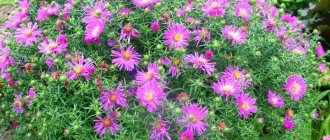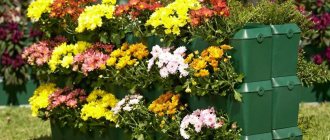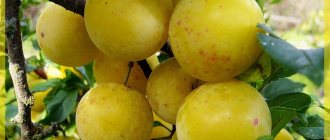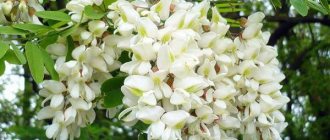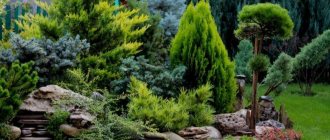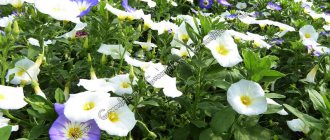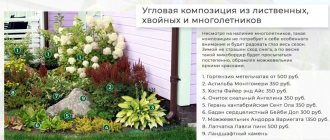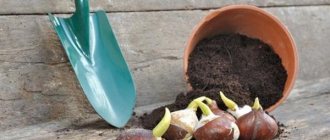Features of mixborders with conifers
At their core, mixborders are complex flower beds of continuous flowering, which, with the right approach, make it possible to enjoy them throughout the year. In general, any conifers can be used to arrange a mixborder, but for harmony it is better to give preference to plants with a height of no more than 1.5 m. If you neglect this recommendation, then tall plantings will stand out greatly among other crops. Among the positive aspects of using coniferous plants to create a mixborder, experienced landscape designers note:
- Relative simplicity in content. Plants are distinguished by their ability to get along well with other plants. It is enough to correctly decide on the planting site at the very beginning and prepare the site in order to eliminate any difficulties in care in the future.
- Long-term preservation of high decorative characteristics (throughout the year). Not only in the warm season does the coniferous mixborder retain its attractive appearance, but also in the cold season - it looks fresh and bright.
- To make mixborders with conifers beautiful, there is no need for significant labor costs. A mixborder with coniferous plants has a neat appearance, does not require frequent shaping pruning, and even novice plant growing enthusiasts can keep it in shape.
- A mixborder using conifers looks equally impressive both in a single color and in a contrasting one. The needles with a bright green or emerald-bluish color look especially luxurious in combination with green shrubs and lush flowering summer plants.
One of the main features of mixborders made from coniferous plants is their ability to look great in any landscape design. Such combined flower beds are also found in gardens designed in the English, Chinese style, and in forest compositions. It is noteworthy that such a solution as a mixborder can not only be a worthy decoration of the local area or garden, but also a kind of space delimiter. They are especially often used to decorate high fences, blank walls, desert areas, and also highlight the line of the garden path.
Mixborder scheme 1 - flower garden of perennials
Mixborder of perennials - diagram
In this example of a mixborder, the bottom row contains:
No. 5 “Cinquefoil shrub”
. Potentilla blooms from July to August. In autumn, the plant is dressed in a mesmerizing golden “dress”. And in winter, its reddish branches stand out noticeably against the white snow.
No. 4 “Coreopsis whorled”
.The low-growing plant blooms profusely and for a long time. From the end of June until the very frost, coreopsis pleases with yellow flowers with different shades: lilac, pink or brown.
No. 3 “Majestic geranium”
. The bush blooms in July for 30-40 days. Geraniums acquire a brick-red or yellow-orange hue in the fall.
No. 2 “Soft cuff”
. This perennial herbaceous plant blooms with small yellow cloud-like flowers from June to July. But gardeners plant mantle in a mixborder of perennials not because of its cute inflorescences, but for its luxurious leaves with a wavy edge.
No. 1 “Geranium Endressa”
. Blooms profusely all summer. In late autumn and winter, it decorates the flower garden with dark green, palmate leaves. The frost-resistant spherical bush is not afraid of temperatures even at – 40C.
The middle row contains the following flowers for mixborders:
No. 5 “Cinquefoil shrub”
(in this mixborder scheme it is located on the right in the bottom row and on the left in the middle row).
No. 6 “Yarrow ptarmika”
. This perennial plant blooms in July and lasts until the end of summer.
No. 7 “Decorative bow”
. Landscape designers often include this amazingly beautiful plant in mixborders of perennials. And that's why. The fact is that decorative onions add a certain charm to any floral combination of a mixborder. Even after blooming on the first day of summer (the main flowering occurs in May-June), dried balls of inflorescences delight the garden until late autumn.
No. 8 “Fennel polygonum”
. The plant with a corolla color ranging from lilac to dark purple reaches a height of 1 m. It blooms from July to August.
No. 9 “Verbena bonarskaya”
. Elegant verbena, strewn with small purple stars, easily fits into any flower garden, even one as difficult to arrange as a mixborder with roses. The persistent plant blooms from June until severe frosts.
No. 10 “Boxwood”
. This slow-growing shrub is not particularly difficult to care for. It is valued not for its small blooms, which are rare but occur in early spring, but for its spectacular evergreen crown.
No. 11 “Decorative wormwood”
. The filigree, lacy leaves of this foliage plant make it unlike any other garden plant. Against its background, an ordinary wildflower seems mysterious.
In the background of the described mixborder scheme the following are planted:
Note that this mixborder is best placed along a fence or wall of a house.
No. 12 "Lofant"
. The versatility of this plant lies in its ability to bloom from July until late autumn. The bush grows quickly and looks incredibly impressive in the background of a mixborder.
No. 13 “Echinacea purpurea”
. A beautiful flower with bright petals has completely unattractive foliage. Therefore, Echinacea is always placed between other plants to create the illusion of a lush flowering shrub.
No. 14 "Khatma"
. The shrub, which sometimes reaches two meters in height, blooms profusely from July until the first frost.
No. 15 "Clematis"
. Velvety delicate flowers of white, pink, blue and red colors delight the eye from early spring to late autumn. Their amazing flowering can only be interrupted by persistent frosts.
The decorative effect of a tiered flower garden can be enhanced if perennial plants are planted in groups, as in the detailed mixborder diagram below:
Tiered mixborder - diagram
It is very important that the group of plants with which you are going to decorate the mixborder have similar needs: requirements for soil acidity and its fertility, moisture supply and light level. So, all the flowers in the diagram presented above grow well in both full sun and sparse shade. They are not too capricious to care for, which means they can be fed and watered in a complex manner.
Which conifers to choose
The main rule when choosing plants for coniferous mixborders is to use low specimens with compact sizes - up to one and a half meters in height. If the plantings are too tall and voluminous, they will not only overshadow the planted ornamental crops, but will also begin to create inconvenience during their further maintenance. They can be considered as components of a coniferous mixborder, but only in small quantities. When arranging a coniferous mixborder, you should take into account the factor of coexistence with other plants, so as not to provoke competition between plantings.
Here is one of the best options for a coniferous mixborder:
- dwarf spruce;
- creeping juniper bushes;
- low-growing thujas, firs, pines.
Important! To achieve the desired result when choosing plants for coniferous mixborders, you need to take into account the width of growth of specific specimens and the presence of difficulties in care. It is better to give preference to plants with the same requirements for living conditions.
Cossack juniper (Juniperus sabina)
Juniper is known for the presence of various species, which, in turn, are further divided into varieties. Creeping varieties of Cossack juniper will dilute the already formed group of coniferous plants in your flowerbed.
It is more logical to plant one of these varieties closer to the edge of the flower garden, so that as they grow they do not shade shorter plants that prefer to grow in sunny areas. But it is better not to plant junipers near paths: constant movement along them can inadvertently injure its shoots.
- 10 plants that don't belong on paths
Do they break, cling to your legs, stain your clothes? Yes, garden plants planted in the wrong place can literally poison your life.
You can supplement a flowerbed of coniferous plants, for example, with Rockery Gem juniper. It is frost-resistant, shade-tolerant and undemanding to soil. Another undoubted advantage is its slow growth (only 8 cm per year).
An alternative is the same slow-growing juniper Tamariscifolia, which does not grow above 1 m in height. Resistant to drought, cold and air pollution. You only need to take care to protect this variety from high humidity so that the juniper does not get sick.
Types of mixborders from conifers
Coniferous plants themselves already have a presentable appearance; they also look great as separate decorative elements of the garden. But for greater effectiveness, it is better to dilute evergreen plants with deciduous shrubs and perennial flower crops. It is important to follow the rules for creating a mixborder.
Mixborders from conifers and shrubs
The combined use of coniferous plants and deciduous shrubs is a classic of the genre. In most cases, a mixborder of conifers and shrubs is made along the fence, near outbuildings, as a hedge, to protect the local area from prying eyes.
Often, coniferous plantings in a mixborder act as a “framework, skeleton” for it, determining both the outline and height. It is best to identify them in the background of a mixborder located near a wall or fence. If the combined composition is located in the middle of the free space, then it is recommended to plant conifers in the center. When choosing plants for decorating the lower tier, you should consider shrubs such as elderberry, magnolia, hibiscus, and lilac. When creating a mixed flower garden, the intensity of growth of deciduous shrubs is taken into account in order to prevent them from rising above coniferous plants.
There is another rather interesting design option for an English mixborder - the main role is given to deciduous shrubs, and the secondary role is given to representatives of conifers, which are placed on the lower tier. Creeping juniper will look great here, the height of which in adulthood rarely exceeds 1 m. Plants should be planted in a mixborder with some interval between them in order to eliminate the lack of sunlight in the future. If dense, improper planting occurs, plants in a flower garden will not only experience a lack of lighting, but also suffer from stagnation of moisture, as the aeration qualities of the soil will deteriorate.
Mixborders of conifers and perennials
Another type of mixborder is also very popular - a flowerbed consisting of juniper bushes, pine, fir, and other plantings in tandem with flowering perennials and herbaceous plants. The undeniable advantages of such mixborders are:
- Quite an attractive look. Against the background of evergreen conifers, flowering perennial plants occupy the most advantageous position. They harmonize perfectly with specimens of delicate pastel shades or rich colors. With this arrangement, perennial coniferous plants in a mixborder immediately attract attention. The site takes on a stylish and noble appearance.
- A mixborder of evergreen shrubs, trees and perennials does not lose its attractiveness throughout the year.
Caring for such a harmonious ensemble is relatively simple; conifers and perennials in a mixborder, planted along the fence, near the building, do not require a special approach. The main thing here is to carry out irrigation measures in a timely manner, loosen the soil, and periodically add nutrients to maintain them in a healthy and beautiful condition.
Photos of coniferous mixborders in landscape design amaze with their magnificence.
Mixborders of conifers, flowers and shrubs
This option for arranging a mixed border near the house is somewhat complex, but is the best picturesque option among other types of mixed flower beds. They use a multi-component composition that includes coniferous plants, deciduous shrubs, and flowers to effectively decorate large, free areas, since a fairly large area needs to be allocated for them.
Here, 3 tiers are arranged, where the main role is given to evergreen or deciduous shrubs, depending on the height of the specimens used, and supplemented with flowers. There are several recommendations regarding the design of a complex composition:
- Tall plantings are placed in the center if the mixborder is double-sided, and in the background - when arranged near a fence or wall.
- The second tier in the mixborder will be planted with specimens that stand out for their medium height. Thus, it is possible to make a beautiful and soft transition from tall to short plants.
- Perennial flowers are placed on the lower tier of the mixborder, attracting the eye with their bright colors and high decorative qualities. This is how the mixborder takes on a complete look.
The use of three-tier mixborders becomes especially relevant when arranging uneven areas of the garden. It is thanks to the peculiarities of alpine slides, where each tier is clearly expressed, that it is possible to effectively decorate any unpresentable corner of the local area or coastline. Most often, this method of decoration is used when decorating the coastal zone near artificial reservoirs, where there are serious differences in altitude.
Important! When designing an English mixborder, you need to correctly distribute priorities so that the planted evergreen trees, shrubs and perennial flowers do not overlap each other, but at the same time do not emphasize sudden changes in height and completely occupy all the available space.
Thus, an interesting option for a mixborder of coniferous and ornamental shrubs and flowers is a flowerbed of tall, spreading bushes of elderberry or lilac, tall phlox or delphiniums (middle tier) and creeping ground cover conifers (lower tier).
Photo of a mixborder of conifers and shrubs using also perennial flowers.
9
Roses and conifers
Roses and conifers in landscape design represent an exquisite combination. The entire color scheme of roses fits perfectly into the emerald green of the conifers. Every gardener can independently come up with a flower garden design.
Roses fit beautifully into coniferous flower beds
Scheme options
Hedge
Roses and conifers in the same flowerbed can create a hedge or border. In this case, the flowerbed is arranged along the paths or fence. Conifers such as juniper, mountain pine, thuja, Canadian or common spruce, etc. are used. Park and remontant roses will complement the picture.
Minimalistic
Hybrid tea varieties of roses, blooming from June to September, look advantageous with western thuja, Cossack juniper, and mountain pine.
Symmetrical composition
Symmetry is created by several pyramid-shaped Canadian spruce trees and dense bushes of polyanthus roses.
Note! Despite the ideal visual combination of coniferous bushes and roses, the gardener must follow the rules for planting these crops. To prevent roses from picking up rust from evergreens, flowers are planted at a distance of 40-70 cm from conifers.
Choosing a location for a coniferous mixborder
To arrange a flower garden with free outlines, as gardeners also call mixborders, you need to correctly decide on the location. To do this you should evaluate:
- soil composition (degree of fertility, moisture and air permeability);
- humidity level;
- degree of illumination.
To avoid such negative consequences as needles burning out under the influence of direct sunlight, it is better to choose clearings where sunny and shadow periods replace each other throughout the day. Areas with bright lighting are not suitable for all ornamental crops. In addition, you should not consider areas where there are through winds; plants should be protected from cold air.
As for the soil, it should not have an excessive level of moisture; too dry soil is also unsuitable for creating a mixborder. If you plant plants in swampy areas, there is a high probability of their root system rotting, which will soon lead to their death.
If you want to effectively decorate a hedge using a coniferous mixborder, then you should not place plants near windows; when they begin to grow, the view will deteriorate. Solid stripes are also not recommended; it would be more aesthetically pleasing to divide it into several zones. In addition, caring for it will be much easier and more convenient. It is advisable to retreat 50 cm from the edge of the garden path.
Advice! When creating an English mixborder, it is recommended to combine plants of warm colors with specimens of the same warm colors, and cold plants with cold ones. The presence of conifers in a complex flowerbed adds moderate severity and restraint to it, which only emphasizes the sophistication of the flower arrangement.
Regardless of the location, plants in a mixborder should be planted in rows. In the foreground there should be specimens with a height of up to 40 cm, the second tier should consist of crops with a height of up to 60 cm, and the third tier should be decorated with plants with a height of 100 cm or more.
Coniferous plants in the design of a rock garden
Conifers look advantageous in combination with stones. Therefore, they are often used in the design of alpine slides. In the foreground, horizontal forms of low-growing pines, junipers and spruces are planted. In the background are spreading bushes of Cossack juniper; the center is decorated with rocky juniper Skyrocket. For variety, deciduous shrubs with an openwork crown shape (barberry, spirea, fieldfare) are added to the composition. Sedum, tenacious, purslane, alpine carnation and other ground cover plants are planted in the cracks between the stones.
How to create a coniferous mixborder
To get the desired effect when arranging a site, you can use a ready-made mixborder scheme, or you can design it at your own discretion. This can be done either on paper or using a computer program. For convenience, you need to make a marking according to the types of plants used, assigning each crop its own color. It is also recommended to take into account the location of decorative stones and other design elements. And don’t forget about garden paths, areas for going deep into the English mixborder.
When planting plants, you should not allow them to become too dense, otherwise it will have a depressing effect on them. Each crop should have enough free space in the mixborder; empty spaces at the growth stage can be filled by planting annual or potted flowers. In the future, permanent plantings are planted instead.
For large-sized specimens, it is quite normal to allocate at least one meter of area, and for medium-sized forms - from 60 cm. If crops with a low degree of resistance to frost are used, then for ease of shelter it is recommended to place them close to each other. When creating a combined flower garden - coniferous mixborder, it is allowed to plant identical plants at certain distances.
Soil preparation
Mixborders should be planted after warm weather sets in, when the threat of return spring frosts has passed. It is quite acceptable to carry out planting work in the autumn, the main thing is to do it a month before the onset of cold weather. Otherwise, the plantings will not be able to take root and will die.
The process of preparing areas for mixborders is carried out according to the standard scheme:
- the area is cleared of weeds;
- dig deep (on the bayonet of a shovel);
- saturate with useful elements (mineral complex, rotted organic matter);
- if necessary, dilute with sand (if the soil is heavy);
- deoxidized with lime or dolomite flour.
To create the most comfortable conditions for the growth and development of mountain and rocky plants, you need to use gravel or expanded clay followed by digging up the soil. It is quite normal for meadow perennials to grow in normal garden soils. At the end of the preparatory work, markings are made in the area allocated for the mixborder according to the plan.
Planting
Large plants with a height of 80-150 cm are planted first, which will form the “skeleton” of a complex flowerbed, setting its height and background. From conifers choose:
- Konica spruce;
- Tuyu Dannika;
- cypress;
- mountain pine Winter Gold;
- juniper scaly.
Among flowering shrubs, the following varieties are excellent for mixborders:
- magnolia;
- hydrangea;
- jasmine;
- hibiscus.
In addition, plants such as:
- Przhevalsky's buzulnik;
- elecampane tall;
- delphinium;
- artichoke;
- multi-grid;
- pampas grass.
In the middle of the mixborder, it is effective to plant vines and tall plants (50-80 cm), which will cover the trunks of trees and shrubs. Works great with this function:
- Rudbeckia is beautiful;
- rudbeckia Golden ball;
- decorative bow;
- Phlox paniculata;
- peonies;
- lily;
- aconite;
- lupine.
You can also dilute the flower garden by planting wormwood pursha, astilbe Thunberg, Chilean gravilate, and milkweed multiflorum. Mixborders made from conifers and roses look original. Thanks to this approach, it is possible to create unique combined flower beds with an English accent.
To cover the bases of planted plants, low-growing crops with bright flowers or original leaf mass should be placed in the foreground. It is especially good to use Korean chrysanthemum, bergenia, daffodils, primrose, tulips, as well as gypsophila and lungwort for these purposes. Among groundcovers, the following are especially valued:
- phlox (subulate, splayed);
- splint;
- Stachys woolly;
- Duchesnea;
- creeping thyme.
If you need shade-tolerant plants, then it is better to give preference to creeping tenacious, hoofed grass, and periwinkle. Of the long-flowering varieties, it is worth choosing purslane or sedum. Barberries, which are distinguished by their hardiness and ability to grow both in sunny areas of the garden and in partial shade, are also suitable for decorating a coniferous mixborder. Upon completion of planting the main components of the mixborder, annual plants such as night violets, asters, marigolds, nasturtiums, and petunias are sown. The contour of the flower bed is decorated with gravel, decorative stone or sand.
Blue spruce Glauca Globosa (Picea pungens Glauca Globosa)
It is more advantageous to place several representatives of this low-growing species of prickly spruce with blue-white needles in the middle of the overall composition. Thanks to its color, it will correctly place accents and force connoisseurs of a well-groomed flower garden to focus their attention first on its center, and only then evaluate the entire ensemble in its entirety. If this rule is not followed, the remaining plants risk going unnoticed. And since such a tree grows slowly, it will cause much less hassle in forming the crown than any other.
It should be remembered that Glauka Globoza spruce prefers to grow on slightly acidic and acidic soil in a sunny place, has high winter hardiness and tolerates drought well. In a word, this is just a godsend for a flower garden in the middle zone. And in terms of its height, it will form a harmonious combination with mountain pine. There are other varieties of blue spruce that are no less worthy of attention.
- Unusual varieties of blue spruce - an interesting solution for your garden
Spruce thickets are not only dark and gloomy.
Schemes of mixborders from shrubs, conifers and perennials
The diagrams will help when arranging your own site.
Combination of thuja with bushes
Traditionally, thuja is considered one of the most successful plants for planting next to tall and creeping shrubs. This is one of the most successful combinations that allows you to create an aesthetic composition. The tree is complemented with absolutely any bushy species, including creeping varieties of coniferous and deciduous bushes. However, the most successful combination is considered to be planting thuja with heather.
Did you know? The oldest thuja in the world grows in the province of Ontario (Canada). The age of this tree is 1.5–2 thousand years.
This plant allows you to create a truly colorful composition, and all kinds of hybrids can fill both the middle and lower tier of the mixborder. At the same time, the bright shades of the flowers will create an excellent contrast to the bright green needles. You can combine conifers with barberry and spirea quite effectively. Their bright and rich leaves of red, burgundy, yellow and golden tones can give high contrast to the needles and make them stand out perfectly against the background of the entire garden.
Caring for coniferous mixborders
Despite the unpretentiousness of the plants used to create a flower garden, in order to maintain their decorative properties, they need to be provided with appropriate care. At the stage of active growing season, weeding should be done, clearing the flower garden of problematic vegetation. You can also do this manually, pulling out the weeds by the roots. The use of herbicides in this case is not advisable.
Feeding procedures are carried out 2-4 weeks after planting. Nutrient formulations with high nitrogen concentrations or complex preparations should be diluted with water according to the manufacturer's instructions. To avoid undesirable consequences, you should pour the working solution as carefully as possible, avoiding it getting on the leaf blades of ornamental plants. Otherwise, there is a risk of burns on them. Such fertilizing is relevant for spring, and in autumn it is effective to apply fertilizers with a predominance of potassium and phosphorus.
Important! You cannot overdo it with nutritional compositions, otherwise a favorable environment will be created for the development of fungal infections and the invasion of parasitic individuals.
For better survival at the initial stage of development of the mixborder, irrigation measures should be carried out regularly. They are carried out as the top layer of soil dries. In the future, when the flowerbed grows, watering is done abundantly, but infrequently. The optimal time for carrying out these procedures is morning and evening hours, using a hose with a sprayer or a watering can. After each irrigation, it is advisable to loosen the soil in the mixborder.
If systematic and serious violations in plant care are not observed, then the likelihood of them being affected by diseases and pests is minimal. As preventive measures, you need to use a soap solution and regularly loosen the soil, remove fallen leaves and faded inflorescences. In the case of dense thickets, adjustments must be made by pruning.
It is possible to fight slugs by installing special traps, which are made from boards or dense material. Dusting with wood ash helps against flea and aphid attacks. If root rot is detected, then diseased specimens must only be removed, and plants that are more resistant to this type of disease are planted in their place. When affected by powdery mildew, the affected parts should be removed.
Formative pruning of coniferous plants in a mixborder is carried out both in autumn and spring. Herbaceous plants are shortened to a height of 5-7 cm. If tuberous or bulbous crops are used, they are dug up and the soil around the bushes is mulched. For the winter, the flower garden is covered with either spruce branches or oak leaves.
Conifers and roses in landscape design in one flowerbed
Landscape design is a hobby for most owners of suburban areas. As a result of their efforts, the space that surrounds both expensive country houses and simple small houses is significantly transformed. Today, vegetable gardens, as well as gardens, are slowly losing popularity and are being replaced by lawns, flower beds, flower beds, original plant compositions, which cannot but please the eye, including a combination of coniferous plants and roses.
If you look at it, flower beds constantly attracted the attention of garden lovers, while conifers were, perhaps, rarely used in landscape design. Lately they are becoming more common
When planting conifers, there is a set of rules that are well known to landscape designers. However, since not all owners of country houses can hire a professional for a lot of money, it is better to remember these rules in order to be able to create real beauty on the territory of your house or cottage with your own hands.
Tree and shrub compositions only look complete if the distance from the point where they will usually be viewed is equal to at least two of their heights. It is best to use a lawn as a background for conifers. There are often cases when coniferous trees are planted near ponds so that they can be combined with weeping seedlings with leaves and recreate a single, unique ensemble. Coniferous compositions look very impressive, as professionals say, when they look west or east in the landscape. It is worth listening to their wishes, as well as recommendations, so that your territory is constantly transformed, and the time you spend outside the city makes you happy every minute.
